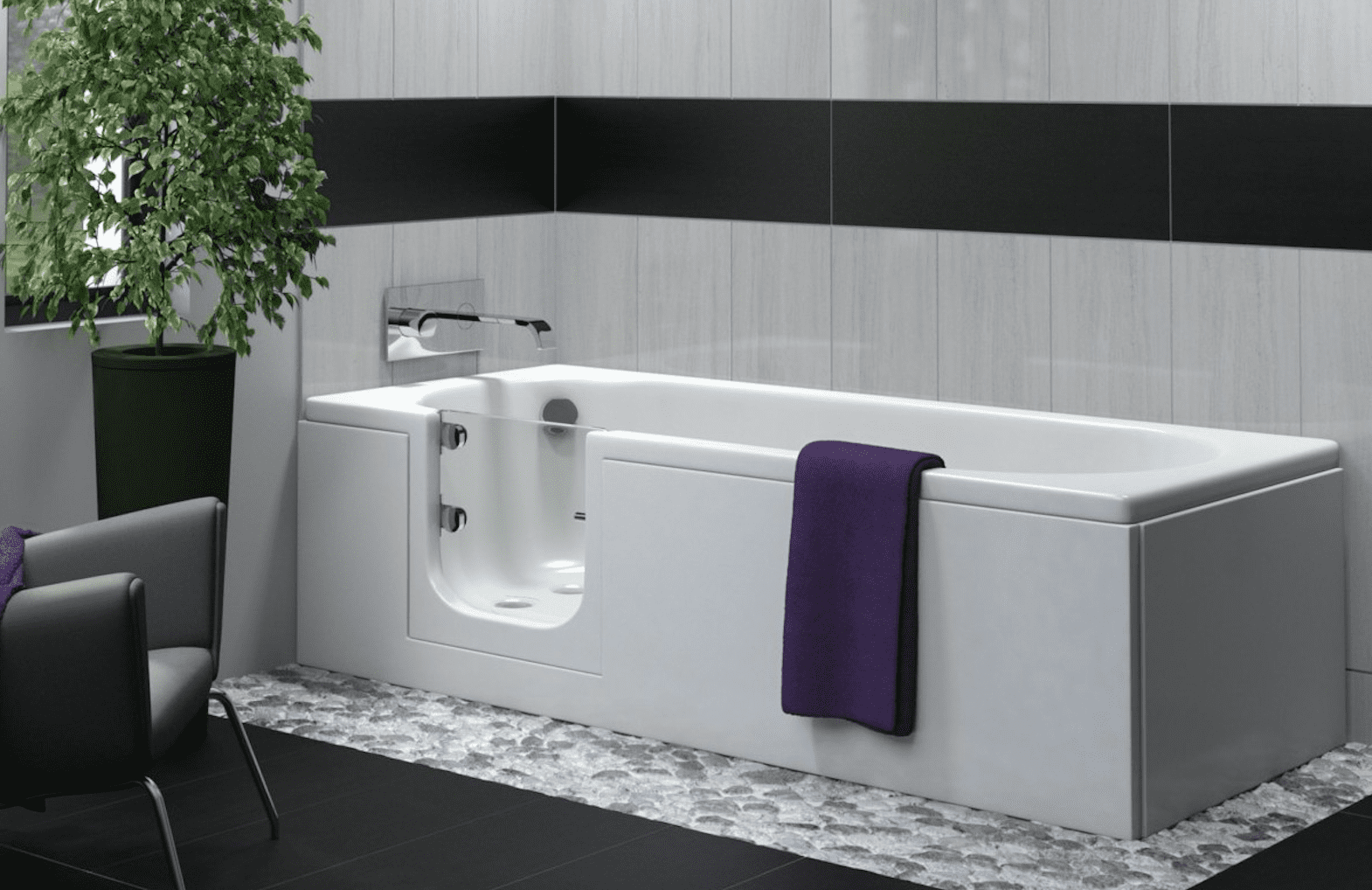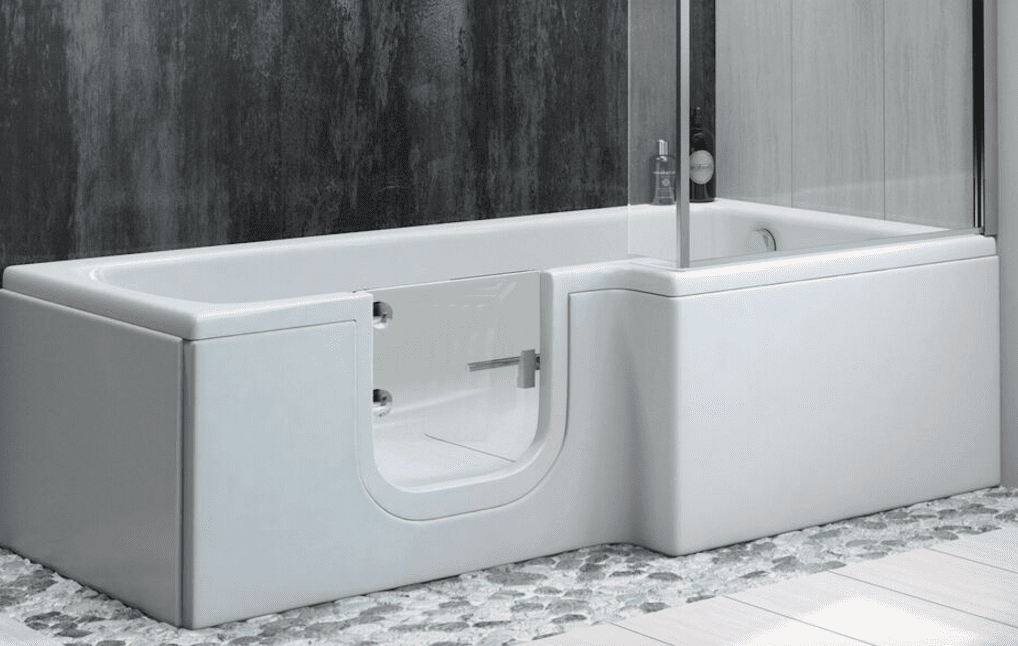How Does A Walk In Bath Work?
Discover how walk-in baths provide independence and relaxation for those with limited mobility, enhancing everyday life with safety and luxury.

In This Post
Understanding Walk-In Baths: An Overview of Their Design and Functionality
Walk-in baths are thoughtfully designed to cater to the unique needs of individuals with limited mobility, such as elderly individuals or those dealing with chronic health issues. These baths provide a safer and more convenient alternative to traditional bathtubs, significantly reducing the physical challenges associated with bathing. For many, the struggle of stepping over the high edge of a conventional bath is a daily obstacle, one that walk-in baths are specifically designed to overcome.
The standout feature of a walk-in bath is their unique door design. Unlike regular baths, which require the user to step over the side, walk-in baths feature a watertight door that allows the user significant entry space to step in and step out of the bath. This design allows users to walk directly into the bath without lifting their legs high off the ground, minimising the risk of falls.
Once inside, users can sit on a built-in power seat, which is typically positioned at an optimal height for ease of use. This seat is designed to eliminate the need for the user to lower themselves to the bottom of the bath, which can be particularly challenging for individuals with stiff joints or limited strength. The powered seat will then return the user to the start position, allowing the user to easily step up and out of the bath, all of which is controlled by the simple press of a button. The power seat can also be adjusted electronically, allowing users to customise the seating position to their comfort level, enhancing both convenience and safety.
The bath's floor is designed with an anti-slip surface, further preventing accidents that could occur when the bath is wet. This texturing provides the necessary traction to keep users stable as they move within the bath. Combined with the easy-entry door, these features make walk-in baths a secure, comfortable solution for anyone struggling with traditional bathing facilities.
Step Inside: The Entry and Seating Process Explained
The process of entering and using a walk-in bath is designed to be as straightforward and user-friendly as possible. For those with limited mobility, even the smallest of inconveniences can become significant obstacles. Therefore, every aspect of a walk-in bath's design focuses on simplifying the bathing process.
The user begins by opening the door, which typically swings outward. This outward-swinging door is not just for convenience but also safety—it ensures that there’s no need for the user to navigate around the door or manoeuvre in tight spaces. The wide door opening is especially beneficial for individuals who use mobility aids like wheelchairs or walkers, providing ample room to enter the bath without unnecessary strain.
Once the door is open, the user simply steps into the bath. For many, this is the most significant advantage of a walk-in bath. Unlike traditional tubs, where stepping over the side can be difficult and dangerous, walk-in baths allow users to walk in with minimal effort.
Inside, a power seat awaits the user. This seat is built for both comfort and support, ensuring that users do not need to lower themselves into a deep tub—a common cause of injury. The seat can be adjusted with easy-to-use controls, allowing users to find their ideal sitting position. After sitting down, the user can close the door, which seals tightly to guarantee any water escaping during the bath.
This entire process—from opening the door to sitting comfortably in the bath—can be done without assistance, promoting independence for those who might otherwise rely on a caregiver. This autonomy is often a significant factor in deciding to install a walk-in bath.

Essential Features of Walk-In Baths
When it comes to bathing solutions for individuals with limited mobility, safety is paramount. Walk-in baths are equipped with a range of features specifically designed to create a secure environment and minimise the risk of accidents.
1. Anti-Slip Flooring: The anti-slip texture applied to the floor of the walk-in bath provides essential traction. This feature is crucial in preventing slips and falls, particularly when the floor is wet. The textured surface grips the feet, offering stability as the user enters, exits, or moves within the bath.
2. Grab Bars: Strategically placed grab bars within the bath add another layer of safety. These bars provide users with something to hold onto as they manoeuvre within the bath. Whether it's stepping into the bath, sitting down, or standing up, grab bars offer crucial support that helps prevent falls.
3. Anti-Scald Technology: To protect against accidental burns, walk-in baths are equipped with anti-scald valves. These valves automatically regulate the water temperature, ensuring that it remains within a safe range. This is particularly important for those with reduced sensitivity to temperature, which can sometimes lead to unintentional scalding in traditional baths.
4. Secure Door Locking Mechanism: The door of a walk-in bath is designed to lock securely once closed. This ensures that the door remains sealed during the bathing process, preventing any water from leaking out. The peace of mind this feature offers cannot be overstated, as it removes the worry of water damage or unexpected flooding.
5. Emergency Draining: Some walk-in baths include a rapid drainage system. In case of any discomfort or emergency, this feature allows the water to drain quickly so the user can exit the bath safely and swiftly. This is particularly useful for those with medical conditions that could cause them to need to leave the bath unexpectedly.
These safety features combine to create a bath that is not only functional but also secure, ensuring that users can enjoy their bathing experience without concern for their well-being.
Therapeutic Benefits of Walk-In Baths with Spa Features
For people with limited mobility, bathing can be more than just a necessity—it can become a therapeutic experience. Walk-in baths, especially those equipped with spa features, offer a range of health benefits that extend beyond cleanliness.
Hydrotherapy, or water-based therapy, is a key component of many walk-in baths. Spa features, such as hydrotherapy jets, are built into the bath, releasing streams of water that massage the body. This massage effect can help alleviate pain in the muscles and joints, making it particularly beneficial for individuals with arthritis or other chronic pain conditions. The warmth of the water combined with the movement from the jets promotes relaxation, easing tension and stress.
The circulatory benefits of hydrotherapy are well-documented. The warm water helps to increase blood flow, which can reduce inflammation and improve overall circulation. This is especially important for older adults, as improved circulation can aid in the healing process and reduce the risk of complications from conditions such as diabetes.
Additionally, the calming effect of hydrotherapy can contribute to better sleep and reduced anxiety levels. For many individuals, the act of bathing in a spa-like environment can be a deeply relaxing experience, helping to ease the mind and prepare the body for restful sleep.
Incorporating these spa features into a walk-in bath means that users can enjoy the luxury of a spa in the comfort of their own home. For those who find it difficult to travel or who prefer the privacy of their own space, this can make a significant difference in their overall quality of life.
How Walk-In Baths Enhance Quality of Life for Individuals with Limited Mobility
The impact of walk-in baths on the quality of life for individuals with limited mobility cannot be overstated. These baths provide a level of independence and dignity that traditional bathing methods often fail to offer.
1. Promoting Independence: One of the primary benefits of a walk-in bath is that it allows individuals to bathe independently. For those who are used to relying on caregivers for assistance with daily tasks, this newfound independence can be life-changing. Being able to bathe without help restores a sense of autonomy, which is crucial for maintaining self-esteem and confidence.
2. Enhancing Safety: The safety features integrated into walk-in baths reduce the risk of falls, burns, and other common bathroom accidents. This not only protects the user but also provides peace of mind to their loved ones, knowing that they are safe when bathing alone. In many cases, the installation of a walk-in bath can be a key factor in enabling individuals to remain in their own homes rather than moving to assisted living facilities.
3. Reducing Stress: The ease of use and safety features mean that bathing becomes a stress-free experience. No longer do individuals have to worry about the physical strain of getting in and out of the bath or the risk of slipping on a wet floor. This reduction in stress can have a positive impact on overall health and well-being.
4. Providing Therapeutic Benefits: Beyond safety and convenience, the therapeutic benefits of walk-in baths, especially those with spa features, add an extra layer of value. Regular use of hydrotherapy can help alleviate pain, improve circulation, and promote relaxation. For individuals dealing with chronic pain or stress, this can be a significant improvement in their daily life.
5. Maintaining Privacy and Dignity: For many people, maintaining privacy during personal care activities is essential to preserving their dignity. Walk-in baths allow users to take control of their bathing routine, ensuring that they can clean themselves in a private and respectful manner.
Walk-in baths offer a comprehensive solution for individuals with limited mobility, addressing their need for safety, comfort, and independence. By incorporating both functional and therapeutic features, these baths not only enhance the physical experience of bathing but also contribute to the overall quality of life. For those looking to age in place or maintain their independence despite mobility challenges, a walk-in bath can be an invaluable addition to their home.

